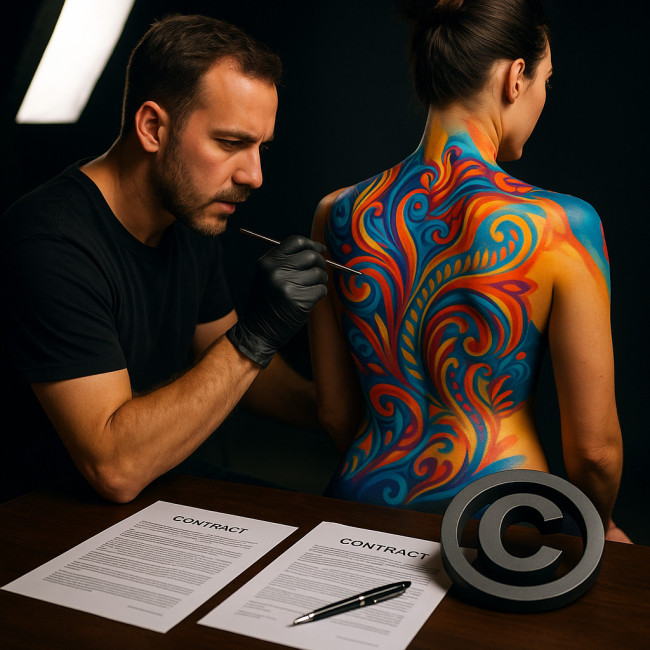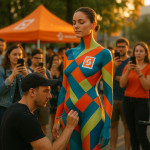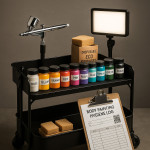Copyright and skin: legal essentials protecting body-painting maquilleur art
Body-painting turns living skin into a fleeting work of art—which makes protecting your creative rights trickier than framing a canvas. This guide walks you through copyright ownership, model consent, photo licensing and the contracts every body-painting maquilleur needs to avoid costly disputes.
Why copyright matters for body-painting maquilleurs
Copyright gives you the exclusive right to reproduce, distribute and license your designs. Without it, brands could photograph your painted models, sell prints or use the imagery in ads without paying you. Clear rights help you:
- Secure fair fees and royalties when images are reused.
- Control how long your artwork appears in campaigns.
- Block unauthorised tattoos or merchandise of your designs.
The skin canvas challenge
Ephemeral medium, enduring rights
Copyright protection applies from the moment paint touches skin, just as it would on paper. Duration follows standard rules (life of the artist + 70 years in most jurisdictions), even though the artwork may wash off in hours.
Document everything
Because the physical artwork disappears, photos and videos become your proof of creation. Date-stamped process shots, time-lapse recordings and signed model releases are vital evidence if you later need to enforce your rights.
Protecting your body-painting maquilleur copyright step by step
- Create a paper trail: Keep concept sketches, pigment invoices and BTS images with time stamps.
- Register when strategic: Copyright is automatic, but formal registration in the U.S., Canada or UK strengthens your position for statutory damages.
- Use clear licence clauses: Spell out media, territory and duration when clients hire you.
- Add accreditation lines: Require “Body-painting by [Your Name]” in credits wherever images appear.
Consent, privacy and model releases
Even if your body-painting profile on Artfolio details your style, you still need a signed release every time paint meets skin. A robust release covers:
| Clause | Why it protects you | Tip |
|---|---|---|
| Explicit consent to paint | Avoids battery claims | Include allergen disclosure |
| Photo & video rights | Lets you publish images for portfolio & social media | Specify unlimited time & global territory where possible |
| Commercial licensing OK | Allows you to earn from prints or brand deals | Offer revenue share to encourage signing |
| Right of revocation | Models feel safer, reducing refusal to sign | Limit revocation to non-commercial uses after payout |
Photographer, brand and venue agreements
Synced contracts prevent “rights gap”
If a photographer or agency commissions you, align all contracts so everyone—the maquilleur, model and shooter—grants matching permissions. Otherwise, a brand may own the photo but not the body art, blocking campaigns at the eleventh hour.
Key points to negotiate
- Usage window: 1 year web banner? 5 years print? Charge accordingly.
- Exclusivity: If a client demands exclusivity in cosmetics, you can still licence the same design for unrelated sectors (music, fashion) unless barred by contract.
- Moral rights: Reserve the right to refuse edits that distort your artwork.
- Credit placement: Negotiate visible credit on captions, packaging or event signage.
International gigs: whose law applies?
Body-painting festivals, cruise activations and fashion weeks often cross borders. Insert a “governing law” clause now to avoid forum shopping later. The Berne Convention grants basic copyright recognition worldwide, but enforcement costs skyrocket once you chase infringers abroad.
EU vs. US comparison
| Aspect | European Union | United States |
|---|---|---|
| Moral rights | Strong, non-waivable | Weak, can be waived |
| Registration need | Not required for lawsuits | Required for statutory damages |
| Database of works | National IP offices vary | Central USPTO system |
Common disputes—and how to avoid them
- “We own the photos, so we own the paint.” Counter with a written clause stating ownership of the underlying artwork remains with you.
- Uncredited social reposts. Use image-tracking tools and friendly DM templates before issuing formal takedowns.
- Unauthorized merch. Send a cease-and-desist; if ignored, file DMCA notices on e-commerce platforms.
Action checklist before your next body-painting assignment
- Save concept art in cloud storage with date stamps.
- Have your model release and licensing template ready to e-sign on a tablet.
- Sync clauses with the photographer's contract.
- Register key designs if budget allows.
- Outline credit requirements in the call sheet.
Boost your legal-savvy profile

Clients love artists who minimise risk. Add a “rights management” bullet in your portfolio bio and link to relevant blog tips. Start with body-painting maquilleur day rates to align budgets, and study UV-reactive pigment safety rules to pair legal compliance with health standards. Brands planning large events can also read this activation checklist for smoother negotiations.
Copyright savvy quiz
FAQ
- Do I always need to register my body-painting artwork?
- Registration is not mandatory for protection, but it unlocks statutory damages and easier enforcement in the U.S. If your design is high-value or part of a big campaign, registration is wise.
- Can the model revoke consent after the shoot?
- Only if your release allows revocation. Most professionals limit revocation to non-commercial use, ensuring paid campaigns stay live.
- Who owns photos of my body art—the photographer or me?
- The photographer owns the photo copyright, while you own the underlying artwork. Licensing must cover both rights to let clients use images legally.
- How do I price extended usage rights?
- Calculate your base day rate, then add a percentage (often 50-100 %) for each new channel, territory or year of use. Tools like Getty's pricing guide provide benchmarks.
Conclusion
You've poured hours into pigments and precision. Protect that investment by tightening your contracts, securing model consent and aligning rights across every collaborator. Ready to level up? Download our contract template pack and lock in your next project with confidence.











